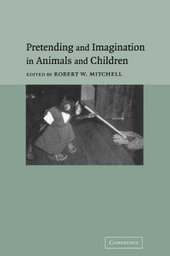
|
Pretending and Imagination in Animals and Children
Hardback
Main Details
| Title |
Pretending and Imagination in Animals and Children
|
| Authors and Contributors |
Edited by Robert W. Mitchell
|
| Physical Properties |
| Format:Hardback | | Pages:392 | | Dimensions(mm): Height 236,Width 158 |
|
| Category/Genre | Animal behaviour |
|---|
| ISBN/Barcode |
9780521770309
|
| Classifications | Dewey:155.418 |
|---|
| Audience | | Professional & Vocational | |
|---|
|
Publishing Details |
| Publisher |
Cambridge University Press
|
| Imprint |
Cambridge University Press
|
| Publication Date |
21 February 2002 |
| Publication Country |
United Kingdom
|
Description
This book provides an overview of recent research presenting conflicting interpretations of children's understanding of the psychology of pretense and describes sociocultural factors which influence children's pretenses. Studies of nonhuman primates provide examples of their pretenses and other simulative activities, explore their representational and imaginative capacities and compare their skills with children. Although the psychological requirements for pretending are controversial, evidence presented in this volume suggests that great apes and even monkeys may share capacities for imagination with children and that children's early pretenses may be less psychological than they appear.
Author Biography
ROBERT W. MITCHELL is Professor of Psychology at the Eastern Kentucky University. He is currently interested in exploring the significance of kinesthetic-visual matching in human and animal behavior, experience and self-understanding, and is writing a history of scientific attitudes toward using anthropomorphism to understand animals. Professor Mitchell's previous books include Self-Awareness in Animals and Humans (1994, ISBN 0521441080), edited with S. T. Parker and M. L. Boccia, and The Mentalities of Gorillas and Orangutans (1999, ISBN 0521580277), edited with S. T. Parker and H. L. Miles.
Reviews'This is a stimulating book. You will find (i) essays of straightforward data whose relation to the larger issues raised seems unclear, (ii) ideas that stimulate your own 'imagination', (iii) detailed statements by some of the better known human researchers of chimpanzees and gorillas, and (iv) how the clever methodologies used to study human children can be appropriated for work with non-human primates.' Ethology
|